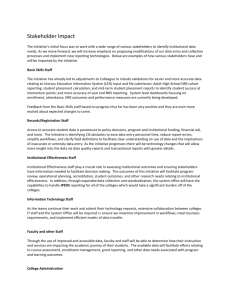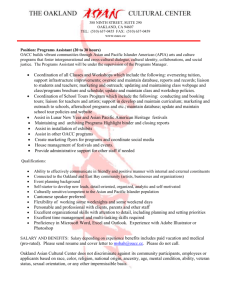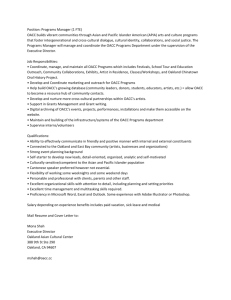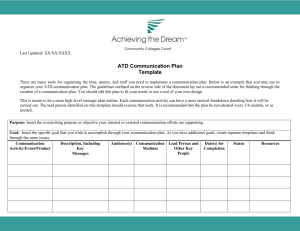Broad_Engagement_Student_Success_Across_the_State
advertisement
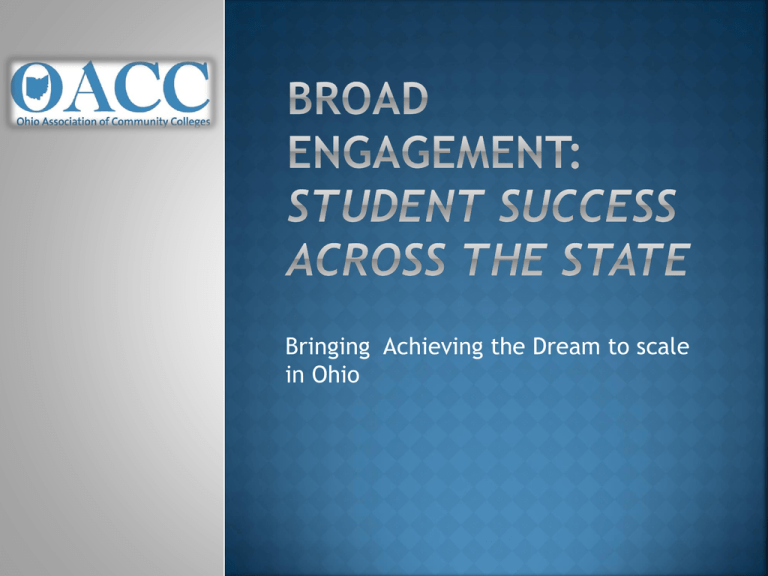
Bringing Achieving the Dream to scale in Ohio Video – Dr. Ron Abrams, President OACC Introducing the Statewide Initiative Thinking Regionally – Conducting regional meetings How Why Lessons learned Participant Engagement – Planning Your Region Statewide follow-up – Preparing for future work Statewide Policy Team Priority – Bring AtD to Scale Development of Statewide Planning Team Representation from each of the AtD Colleges Draft agenda/template developed by OACC Utilized conference calls to facilitate meeting planning December 2010 Meeting – Building Ohio’s Community College Student Success Presidents and CAO sent save the date information that identified suggested team composition CAO IR Dev Ed Faculty Agenda Plenary Topical breakouts/small group discussions Peer group networking luncheon Regional breakouts Committee Leadership Use of Evidence to Improve Programs & Services Broad Engagement Systemic Institutional Improvement Introductions What one principle or practice from the ATD Field Guide is your institution doing well? From Developmental Education to Completion: The State and National Agenda Committed Leadership and Use of Evidence What are your strengths and challenges in these areas? What steps can you take to overcome your challenges and leverage your strengths? Sharing and Feedback Broad Engagement and Systemic Institutional Improvement What are your strengths and challenges in these areas? What steps can you take to overcome your challenges and leverage your strengths? Using Data: Understanding Who Our Students Are and Making Data-Driven Decisions What story is your data telling you? Aha Moments! Next steps Rethink the use of “developmental education” vs. “student success” Don’t reinvent the wheel . . . talk to other institutions Create a schedule of town hall meetings to communicate developmental education initiatives The Ohio two-year colleges are trying to prepare a coordinated position on Achieving the Dream We need to collect more data Confirmed my intent and desire to establish a Student Success committee that invites members from all academic and student affairs divisions/departments and that includes students, faculty, staff, and administrators Inclusion of technical faculty in the discussions Allow more time for sharing developmental education best practices from each college Create a list of meeting or anticipated meeting “outcomes” and send that list to us before the meeting so we can work toward achieving some clearly understood outcomes. An outcomes based meeting will probably help us to use our time more judiciously 1. 2. 3. 4. 5. 6. 7. 8. 9. 10. Communication and Collaboration make everything happen Faculty matter - Core Team expanded to include faculty/ faculty leader/ faculty development Data analysis counts “Students don’t do optional” - policies are needed (no late registration, orientation, pre-requisites, student success class) Go to the experts – read, attend conferences, bring them in; try it: Supplemental Instruction; Collaborative Learning; My Labs Location matters (tutoring center, counseling, etc.) Student Ambassadors are an integral resource (peer mentors, peer leaders) Outreach matters– tutors, instructional specialists go to classrooms Learning communities – there’s more to it than pairing courses Training matters - sessions for tutors with Instructional Specialists and Dev Ed faculty (tutors include adjunct faculty, part-timers, etc.) Most Valuable: Makeup of Host Group Self-ratings Use on Readiness Assessment of AtD metrics Takeaways: Personalize Be and pave the way realistic Everyone needs team time 10-10:15 am student Welcome – Martaraiesa Fiala, Eastern Gateway Introductions and Meeting Purpose – Christina Wanat, Chief Administrator of Student Development 10:15-11:30 am Breakout Sessions – 20 minutes per session 1. Committed Leadership – Dr. Meek(Vision, values, starting core and data teams, etc.) 2. Use of Evidence for Improvement – Patty Sturch, Dean of Enrollment Management (IT/IR capacity, process for identifying achievement gaps, evaluating programs, etc.) 3. Broad Engagement – Ann Koon, Director of Public Information (Engaging faculty, staff, students and external stakeholders) 4. Systemic Institutional Improvement – Dr. Robin Snider-Flohr, Dean of Allied Health Careers, Biological Sciences and Public Services (Institutional management and planning, organization, professional development) 11:30 am-12:15 pm Networking Lunch 12:15-1:15 pm Quantitative and Qualitative Data Presentation – Patty Struch 1. Data drives decisions. Reviewing your college and using data are crucial to making and moving decisions. Overview of the available quantitative data and examples of how qualitative data has been helpful. Discuss collection, analysis, use and reporting of data. 2. Discussion on how colleges will start submitting data to HEI in a JBL-like format beginning summer 2012. 1:15-1:45 pm Individual College Breakouts Colleges work in separate groups to discuss College Readiness Assessment and to discuss use of data and brainstorm initiatives on which to seek data to make decisions before initiative implementation. 1:45-2 pm Wrap-up and Next Steps – Christina Wanat 2010 ANNUAL PLAN PERFORMANCE MEASURES FY 2011 Actual PART I: STRATEGIC OBJECTIVES Increase College Participation and Attainment FY 2012 Target FY 2012 Current YTD Develop a program to become a leader in developmental education D Become a center of excellence for math Increase to 25% the number of students who transfer by 2015 COMMENT STATUS D 15% 18% 83% 91% 48% 60% Passrate of redeveloped MTH095 was 50.9% for FY2011. Curricular changes to improve student success and retention go into effect Fall 2011. Fall 2011 passrate for dev ed English was 58% Fall 2011 passrate for dev ed Math was 56% Passrate for FY2011 for all Math courses was 66.4%. Based on IPEDS report 3/2012. All non degree students were excluded from this calculation Based on IPEDS report 3/2012 Based on IPEDS report 3/2012 EGCC’s Welding Fabrication Program is being re-activated with OBR for the Spring 2012 semester College is expected to double Fall 2010’s enrollment of 354 Enrollment numbers reflect activity through 1/2/2012 Initiated text book rentals at bookstore Bookstore now selling used books Began discussions in Administrative Cabinet Received a 13.9 million dollar Federal grant through Job and Family Services for expanded health programs (HOPE) The College was awarded an EOC grant for the expansion counties for $214,000/year for 5 years. Preparing for resurfacing of parking lot at Pugliese Center Wellness Center and Administrative Offices renovations complete. Continually monitor revenues and expenses per approved budget Strengthen Student Achievement by 2015 by increasing: Fall completion rate for new deg seeking students Fall to fall retention rate of deg/cert seeking students Graduation rate (as defined by IPEDS) 23% 30% 86.8% 80% 46% Pass rate for MTH120 (first college level math) Pass rate for ENG101 (first college level English) 75.8% 80% Overall gatekeeper course pass rate 62.9% 70% Overall course success rate (c or above) 76.5% 85% 271 281 Increase number of students engaged in internships and co-ops by 42% by 2015 266 376 Increase number of P-16 partnerships with emphasis on two and four year colleges D Develop programs to meet current and future employer needs D Total degrees/certificates awarded annually Engage and Support Business and Industry to Foster Economic Leadership Maximize College Access and Affordability Achieve 1,000 enrollments on campuses located in Mahoning, Columbiana and Trumbull Counties by Dec 2012 Fall - 354 Sp - 488 Fall – 708 Sp - 976 Fall - 698 Sp - 550 Increase STEM degrees awarded by 46% by 2015 169 Increase degrees to first generation college students by 131% by 2015 Reduce text book costs to students (including the use of free on-line text books) Increase degrees awarded to Black and Hispanic students by 10% by 2015 Build Community College Resources to Promote Access and Quality Learning Expand College Foundation and Endowment by 34% by 2015 Raise $75,000 in Scholarship and Endowment Funds specifically for Mahoning and Trumbull Counties by 2015 Develop college succession plan 66 78 95 D 16 20 $575,155 $679,476 $4,500 $15,000 D Achieve new funding from at least 5 new sources $603,710 D Develop Master Facility Plan D Complete current renovation projects D Financial Stewardship Performance to Budget (net income) D Share Student Success Initiatives Focused Discussions on College Assessments (leadership, using evidence, engaging all, systemic improvement Data Presentation Individual college work time More time needed for data analysis and discussion More faculty participation Discussion – potential leadership & policy implications College Readiness Assessment Sharing Campus Interventions & Activities Next Steps Colleges Data completed and submitted to OACC shared with Leader College in aggregate form Aggregate data shared with group – imbedded in this is discussion/reflection regarding the four AtD Principles Regional SWOT analysis Data points to be identified by Zane State Data collection via Zane State – Institutions to submit data Spring 2012 Identification of Regional Success Measure – Summer 2012 Institutions share proposed intervention – Summer 2012 Implementation of Intervention – Fall 2012 Identify the entity in your state or region that could take the "convener" role that OACC plays for Ohio Consider the feasibility of scheduling an "all colleges" meeting to kick things off, any potential locations How could you organize and assign the nonAtD Colleges in your state/region? Consider potential time(s) of year to host college-to-college meetings Identify unique barriers or challenges for your state/region Participants emphasized need for additional State-level meetings Expressed desire to learn about the work of AtD and more broadly engage the student success agenda Desire to learn what is going on at other institutions Participants question the utility of additional regional meetings at the current juncture Greater engagement of faculty March 2011 – OACC Statewide Symposium Stan Jones – Complete College America Vincent Tinto – University of Syracuse Summer 2011 – Regional Meetings December 2011 – Ohio’s Student Success Agenda Shanna Smith – Jaggars CCRC March 2012 - OACC Statewide Symposium April 2012 – Statewide Math Summit Thank you for your time and attention
